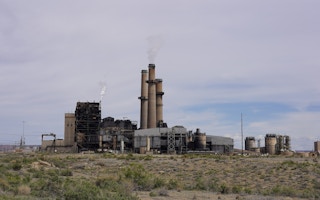Pumping money into carbon capture technology may not guarantee its growth to the scale needed to tackle the climate crisis, according to a new report highlighting investment risks in the sector.
To continue reading, subscribe to Eco‑Business.
There's something for everyone. We offer a range of subscription plans.
- Access our stories and receive our Insights Weekly newsletter with the free EB Member plan.
- Unlock unlimited access to our content and archive with EB Circle.
- Publish your content with EB Premium.
Sustainable Fitch, an arm of the New York-based financial services giant Fitch Group, says key issues include technological hurdles and how several existing carbon capture, utilisation and storage (CCUS) projects have missed performance targets, shut down early or been canned.
Governments worldwide, most notably the United States and China, have said the technology is key to their decarbonisation goals. According to the International Energy Agency’s 2050 global net-zero scenario, CCUS capacity needs to grow by 40 times from present to reach 1600 million tonnes of carbon dioxide in the next seven years. However, Fitch Group forecasts that the capacity will not even hit 200 million tonnes by then.
There are about 30 CCUS projects operational today, where various filters and chemical concoctions are used to trap carbon emissions from the smokestacks of polluting industries, such as power generation and natural gas processing.
Such projects would face “considerable uncertainties” in the future, the Fitch report said, due to long project timelines, uncertain demand and the falling cost of renewable energy.
Meanwhile, pairing CCUS with fossil fuel power generation has already proven difficult. Attempts to retrofit the technology at coal plants have stuttered due to both technical and financial obstacles, while there has been no successful implementation at commercial gas plants.
Clean energy options would present less competition in industrial sectors with few fossil fuel alternatives, such as in steel and cement making, but such CCUS applications are also in their infancy, Sustainable Fitch said. While the technology could be key to decarbonising cement, clean hydrogen fuel made from renewable electricity is expected to pull ahead for steel.
“As the failure to reach targeted capture rates or cost improvements of CCUS technology in more mature applications has shown, investing in such a high-risk and capital-intensive technology in sectors where low-carbon alternatives are available does not seem a sustainable solution,” the report said.
Given the challenges, “it is unclear how investments in CCUS projects will be able to close the gap in the short to medium term”, it added, referring to the shortfall in carbon capture capacity against major net-zero scenarios.
However, Sustainable Fitch said that hefty tax credits, such as those provided by the United States in its landmark climate bill last year, could help improve the prospects of CCUS, along with carbon taxes and green finance rulebooks that allow for the use of carbon capture technology – such as in European Union jurisdictions.
Major economies in Asia are also building up their carbon capture capabilities. Apart from China, industrial powerhouses South Korea and Japan are proponents of the technology, and support efforts in Malaysia and Indonesia.
There is support at global climate fora, where conventional fossil fuels have been sidelined in decision texts, but not those paired with CCUS, Sustainable Fitch noted.
Reputation risk
Investors could face blowback by putting money into CCUS projects due to its links with the fossil fuel industry, Sustainable Fitch said. In most applications today, the captured carbon dioxide is used to squeeze more petroleum out of oil wells, thus worsening greenwashing risks for investors.
While the growing voluntary carbon markets could help fund carbon capture projects, the report noted that they offer limited co-benefits and “less appealing [public relations] opportunities” compared to nature-based solutions, which also tend to be cheaper.
Projects that pledge to store carbon dioxide permanently underground, instead of using the gas downstream, could still benefit from market demand for high-quality carbon offsets, the report said. However, such activity would not generate any revenue to offset the cost of building and maintaining carbon capture facilities.
“Uncertainties with regards to technological developments, revenue streams, implementation costs, transportation challenges, storage considerations, public support and risk of greenwashing allegations need to be considered and understood by investors and corporates at early stages of any project,” Sustainable Fitch advised.
Last year, consulting firm McKinsey said that US$130 billion a year of investments is needed to sufficiently expand CCUS capacity to reach net-zero emissions by 2050. Investments in 2021 totalled US$2.3 billion, down from US$3 billion the year before, according to Bloomberg data.










